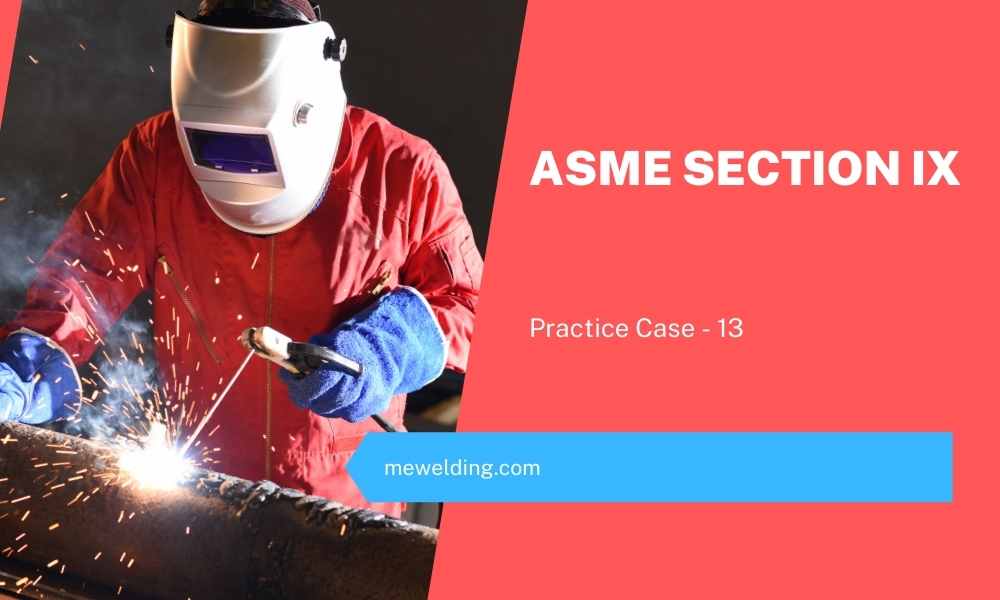This article deals with an example of multiple PQRs used to support a single WPS, with a focus on the special exemption of QW 200.4 for root deposits.

Consider the following questions asked in Interpretation IX-17-77.
“Background: A combination GTAW and FCAW WPS is supported by two PQRs performed using the same base metals and the same PWHT below the lower transformation temperature. Impact testing was performed.
PQR A is welded with GTAW to join 13 mm thick plates with 13 mm of GTAW deposit. PQR B is welded with FCAW to join 40 mm thick plates with 40 mm of FCAW deposit.
Question: Do PQRs A and B qualify the combination WPS for a base metal thickness range of 16 mm to 200 mm when impact testing is required?”
Let us tabulate the given information in a table.
| PQR 1 | Actual value in test coupon | Range Qualified |
| Process | GTAW | GTAW |
| Base Metal thickness | 13 mm | 13 mm to 26 mm (Per QW 403.6 and QW 451) |
| PWHT | Below lower transformation temperature | Below lower transformation temperature (Per QW 407.1 and QW 407.2) |
| PQR 2 | Actual value in test coupon | Range Qualified |
| Process | FCAW | FCAW |
| Base Metal thickness | 40 mm | 16 mm to 200 mm (Per QW 403.6 and QW 451) |
| PWHT | Below lower transformation temperature | Below lower transformation temperature (Per QW 407.1 and QW 407.2) |
The FCAW PQR completely meets the requirements of the question. However, at the first glance, it seems that the GTAW PQR, which is qualified for only the 13 mm to 26 mm thickness range, cannot support the WPS in question.
However, that is not true. The GTAW PQR can support the production weld in question. Let us see how.
When using a combination of PQRs for a single WPS, QW 200.4 gives a provision for qualifying the WPS for only the root deposit in accordance with the exemption provided in QW 200.4 (b).
The exemption in QW 200.4 goes something like this: Imagine that you have two PQRs, one of them should be at least 13 mm thick, and second with any other greater thickness. Then the first PQR can be used to lay root deposits, up to a deposition thickness of 2t (t = deposition thickness in first PQR), in a base metal of maximum thickness permitted by the second PQR. This is permitted only for SMAW, GTAW, GMAW, SAW and PAW processes.
Using this exemption, the first PQR in the question above can be used to lay root deposits up to a deposition thickness of 26 mm maximum, while the remaining is filled by FCAW, in base metals of thickness range 16 mm to 200 mm.
However, there is a caveat to this. The exemption in QW 200.4 is only for root deposits. The question written above does not mention that GTAW is only going to be used for root deposits. The answer given by the ASME is a yes, which in all likelihood, has been given by keeping the exemption given in QW 200.4 in consideration.
There is no other way the question can have a ‘yes’ answer otherwise.
So this was about an example showing use of multiple PQRs for supporting WPS for a single joint, and how QW 200.4 helps us get around the qualified base metal thickness restrictions of QW 451. Please do leave your thoughts in the comments section below.
See More:
Supplementary Essential Variables As Per ASME Section IX

If we Have 22mm plate to be welded with Root by GTAW & Fill Pass by SMAW, we have two PQR supporting this with one PQR Qualified with Coupon Plate Thickness is 6mm for GTAW Process supported by seperate WPS and second PQR Qualified with Coupon Plate Thickness is 16mm for SMAW Process supported by Seperate WPS.
Can we use this two PQR & Two WPS for welding the Plate having 22mm thickness Shell Plate.
Hello. A PQR with 6 mm base metal thickness does not support production welding of 22 mm base metal thickness. It supports only up to 12 mm.
In this case, the exemption of QW 200.4 (which is what you were perhaps hoping for) is not applicable. Because, the exemption given in QW 200.4 for root deposits requires the PQR for root welding to be at least 13 mm thick (in base metal thickness).
I hope this answers your question.
If I have 2 PQR separate as following:
1. GTAW coupon test thickness is 6
2. FCAW: coupon test thickness is 16
In that case,
Q1: Can I written a combination WPS with supporting from above PQRs? if no, why?
Q2: If yes? what are max. base metal thickness range qualified of combination WPS?
Hello. Here is my understanding on this. The qualified base metal range of GTAW PQR is 1.5 mm to 12 mm in accordance with QW-451. And the qualified base metal range of FCAW PQR is 5 mm to 32 mm in accordance with QW-451. Using the two PQRs mentioned in your question, a combination WPS can be written. But the base metal thickness range would only be 5 mm to 12 mm (the overlapping range in base metal thickness).